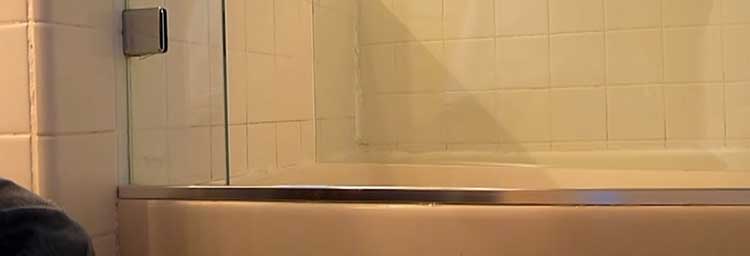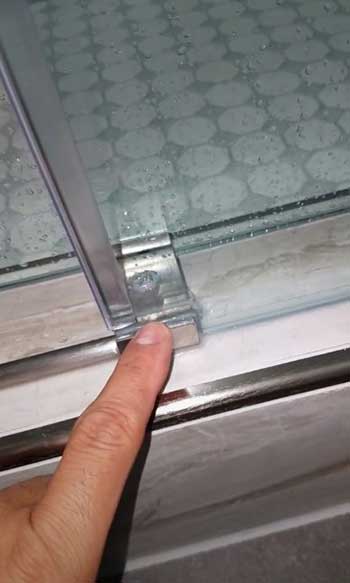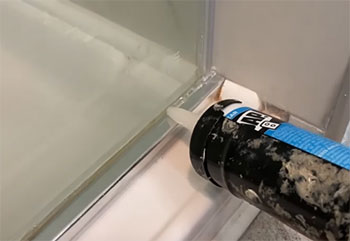Water splashing under the sliding shower door can become a homeowner’s worst nightmare. What may seem like a minor problem now can become a serious cause of expense in the future.
So, it is better to know about the causes and possible fixes to water leakage under the shower door.
This way, you can avoid any expensive repairs in the long run. Nip the problem in the bud.
Intro to Water Leaks Under Sliding Shower Doors
If you notice pooling water outside your shower, it likely means your sliding door isn’t sealing properly. Gaps or misalignments allow water to splash out and leak across the floor.
While quick fixes like towels may help temporarily, they don’t solve the root issue. To prevent leaks for good, you need to address the specific source of the problem.

Potential causes include:
- Poor door alignment
- Gaps between door and walls
- Clogged or missing door seals
- Loose or damaged hardware
- Improper slope of shower floor
- Crack or chip in door glass
In the majority of cases, fixing alignment issues, sealing gaps, or replacing damaged parts stops the leaking for good. But first, you must diagnose the exact problem.
In this guide, we’ll walk through the common causes and targeted solutions. With some adjustments and easy repairs, you can stop water in its tracks and contain it inside the shower.
How To Detect The Source of Water Leakage In Your Shower?
If you notice a big puddle of water outside your shower, it is time to inspect your shower for the problem. These are the places you should give a check:
- The position of your shower head
- Shower door seals
- Shower door sweeps and shower door track
- Shower curb
- Along the wall
- Shower door hinges
These are the places you must inspect to find out the source of water leakage. To know why; keep on reading to find out what causes water leakage from shower doors.
What Causes Water Leakage from Shower Doors?
There could be a number of reasons behind your glass shower door leaking at the bottom. It is best to know what these reasons could be to identify the core of the problem.
Usually, shower door water leakage is caused due to:
- Defective caulking
Usually, caulk is used to seal the edges of the shower doors. This is done to stop the water from leaking, both in framed and frameless doors.
In many cases, the installation of caulking could be improper. While in some, it could be that the caulking has worn off. This leads to the shower door leaking water.
- Defective Shower Door Sweeps

Sweeps are usually attached to frameless doors to prevent water leakage just like caulking. If there is a defect in the installation, then it may cause shower door water to leak.
- Wrong Installations
As you know, the shower doors are bolted to the wall with hinges. If the installations are not done right, in most cases, a gap remains in the sides. This allows space for the water to leak.
- Blocked drain holes
Most framed showers have to drain holes or rails at the bottom edge to drain out any water that may enter into the shower drain.
If these drain holes get blocked for any reason, the water starts leaking outside the door due to overflow. Usually framed sliding shower door leaks at the bottom due to blocked drain holes.
- Leveled Shower Curbs
Slanted shower curbs keep the water inside the shower. The slanted position of it allows the water that falls on the curb to run back into the shower.
Faulty constructions may result in leveled shower curbs. So, it does not stop the water from flowing outside the shower.
- Defective Track
Sliding doors have a track installed that allows the door to slide back and forth.
If there is a defect in the track such as loose installation, then the doors do not seal properly. That results in the water splashing under the sliding door.
Now that you know what causes framed sliding shower door leaks at the bottom, there are some signs you should look out for other than just the big pool of water outside your shower.
- Major water leaks usually end up staining the walls or floor so keep an eye out for that.
- Water leaks also may create molding on the floor, which may give off a putrid smell.
- Other than that, if you notice your water bills have spiked, the probable cause would be an unnoticed water leak.
How To Fix The Water Splashing Under The Sliding Shower Door?
So, you know the signs to look out for and the probable causes. Keep on reading to know what you can do to fix the water from splashing under the sliding shower door.
- Fix The Caulking

As the caulking acts like a seal that prevents water from leaking, fixing it will take time and patience.
Caulking can be removed using razor blades. Keep in mind you have to caulk the wall that the door connects to.
So, if the caulking has worn out or it was defective, to begin with, you have to remove it completely.
Once you have removed it, you have to use light-grade sandpaper on the surface to make sure any excess adhesive is removed.
After that, it is time to re-apply the new adhesive and then apply fresh caulking again.
Try to go for a silicone caulk as it lasts longer than other caulks. Usually, acrylic caulks harden or crack easily.
Silicone caulks do come in clear, white, and grout colors.
So, clear silicone would be a good choice for the shower doors.
Do not overdo with the caulk. It is not necessary that more caulking means a higher chance of preventing water leakage. Less is sometimes better.
Also, you should keep in mind to avoid caulking over the drain holes in the shower. If they get clogged, water overflow will cause more water leakage.
And make sure the caulk you are using is meant for bathroom areas.
- Fix the Defective Track
Tension screws are used on the door track to keep the sliding doors tight. You will have to loosen these screws so that you can take the door off the track.
Then you remove the frame by taking the screws off. Once you take off everything, you can take off the track by unscrewing it.
Next, install the new track and reinstall the frame and the door one by one.
- Filling Gaps Around Frame
If water leaks around vertical door edges or top frame, small gaps may be the issue. Normal wear, loose hardware, or settling can create slight gaps between the frame and walls. These let water escape the enclosure.
Inspect closely for light visibility around frame and tiny splashing during showers. Have someone run the shower while you check outside for escaping water droplets.
Seal any small gaps or openings with silicone caulk. Allow the shower to fully dry before applying. Force caulk into openings by spray misting it first or using a caulk backer rod.
Focus on top corners, side edges where walls meet frame, and along the threshold. Smooth and wipe away excess caulk for a watertight seal. Caulk shrinks slightly when dry, so apply multiple coats if needed.
- Adjusting Shower Floor Slope
An improperly sloped shower floor can cause leaks under sliding doors and correctable. Adjusting the slope improves drainage and reduces water splashing out.
Check floor areas near the door threshold using a level. Water should drain towards the opposite end and down the central drain.
If floor sections are flat or slope the wrong way, leaks will persist. High spots block water from draining properly while low areas accumulate pooling water.
Build up low areas with thinset mortar applied beneath tile, then flatten with a trowel. For small high spots, carefully grind down using an angle grinder or tile file. Feather smooth.
Adjust slope in 1/8” increments gradually. Test shower drainage until water runs consistently under door and to drain. Avoid too steep a slope.
A well-draining floor directs water away from the door threshold. Combined with proper door seals, this stops leaks. Update damaged grout once slope is corrected.
- Replacing Broken Glass and Components
Sometimes a sliding shower door begins leaking after sudden physical damage occurs. Fractured glass, broken rollers, and missing hardware must be replaced.
Inspect glass panels carefully for any cracks or chips along edges and corners. Even small fractures allow water to seep through. Replace broken tempered glass immediately before cracks grow larger.
Check rollers and wheel housings for cracks as well. Broken rollers won’t roll smoothly and can misalign doors. Remove rollers and hardware to bring to a glass shop for identical replacements.
For sudden leaks, go over the door thoroughly looking for any other broken parts. Catch issues early before damage worsens and more repairs become necessary.
With quality replacement parts installed, the door should operate smoothly and seal correctly again. Take care handling broken glass during the repair process.
- Install a Shower Door Sweep/Seal
To avoid the water splashing under your door, you can install a shower door sweep under the door. They act like shower door leak guard preventing water splashing under the door.
Usually, shower door sweeps come in different sizes to fit different shower glass doors.

Figure out the thickness of your shower door before the installation. The shower door thickness has three measurements:
- ½ inch
- ¼ inch
- ⅜ inch
Once you have figured that out, it is time to figure what type of seal you are using. Typically, there are three types of seal used:
- Vinyl Slide On Seal: Made of clear viny and used in most shower doors.
- Metal Bracket Rubber Seal: The rubber seal is sandwiched inside the metal bracket by screws.
- T Style Seal: Mostly used for shower doors with metal brackets. Comes in a clear vinyl form with a T shaped top.
One of the frameless shower door problems is that the seal starts to get brittle over time.
But whether it is framed or frameless, Old Sweep/Seal are easy to move once they become old and torn out. So, grab onto it and pull it off.
Now use a mild cleaner and a microfiber cloth to wipe the surface and remove any scum or residue that may have been deposited there.
It is more convenient if you cut the length of the seal strip longer than the section you will install it on.
So once you are done cutting, start the installation process. Press one end of the seal/sweep on the corner of the door. Push it into place from that corner and move on to the other end.
Once it is all snug and tight in place, trip the extended piece of the seal. Take a craft knife to trim the seal carefully.
As the installation is complete, you will notice there are no more shower door drips when open.
If none of these solutions seem to fix the problem, it is time to call in a professional. and please keep in mind, it is not mandatory that you use these fixes.
If you feel hesitant, it is better to call a professional to check out first.
How To Prevent Water Leakage Under The Shower Door?
It is best that you get professional services for your shower installations. That way, you can avoid any mishaps from the beginning.
But here are some tips to prevent the water from splashing under the shower door:
- Make sure you position your shower head towards the wall. If it is positioned towards the door, it increases the chances of water leaking out the door.
- Always check the hinges for rust or defect. The gap can give space for water leakage.
- Lastly, check the door for any scum or limescale build-up which may create a hindrance to closing the doors.
Maintenance and proper upkeep are the keys to preventing any damage to your property.
FAQs
Check door alignment, inspect seals for damage, fill wall gaps with caulk, and adjust floor slope. Replacing worn seals and hardware will help stop leaks under sliding shower doors.
If water leaks under the door, it’s likely due to misalignment, worn door seals, gaps along walls, or improper slope. Cracked glass and broken parts can also cause leaks to develop suddenly.
Leaks under a sliding glass shower door typically mean the bottom sweep seal needs replacing. But also check alignment at bottom edge and the door’s height clearance. Adjusting the floor slope can help reduce bottom leaks.
To stop shower leaks under doors, first determine the exact source – worn seals, wall gaps, slope issue, or alignment problem. Replace seals, caulk gaps, adjust rollers, and slope floor away from door to prevent leaks.
Final Words
We hope that this article has provided you with some insights on the causes and fixes for water splashing under the sliding shower door.
Keep in mind there could be different reasons why your shower door is leaking.
Take your time to inspect and figure out the source of the problem. Do not be hasty. And always try to follow up on maintenance checks.
